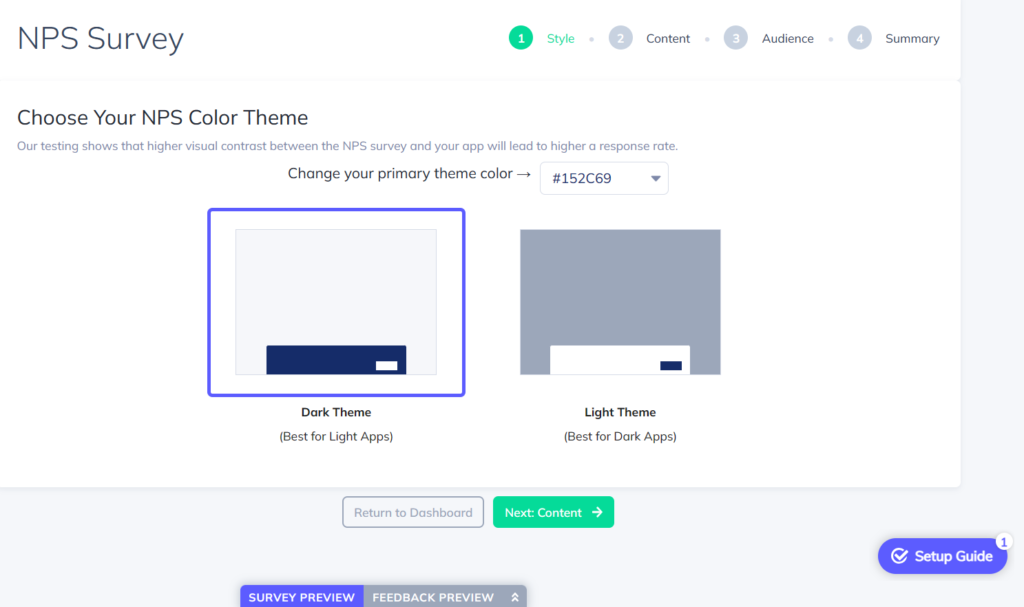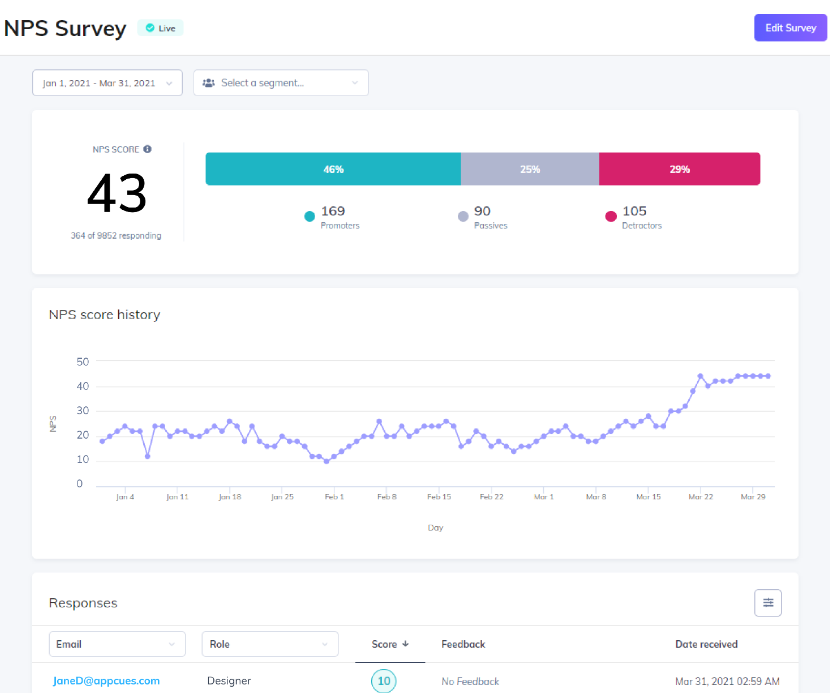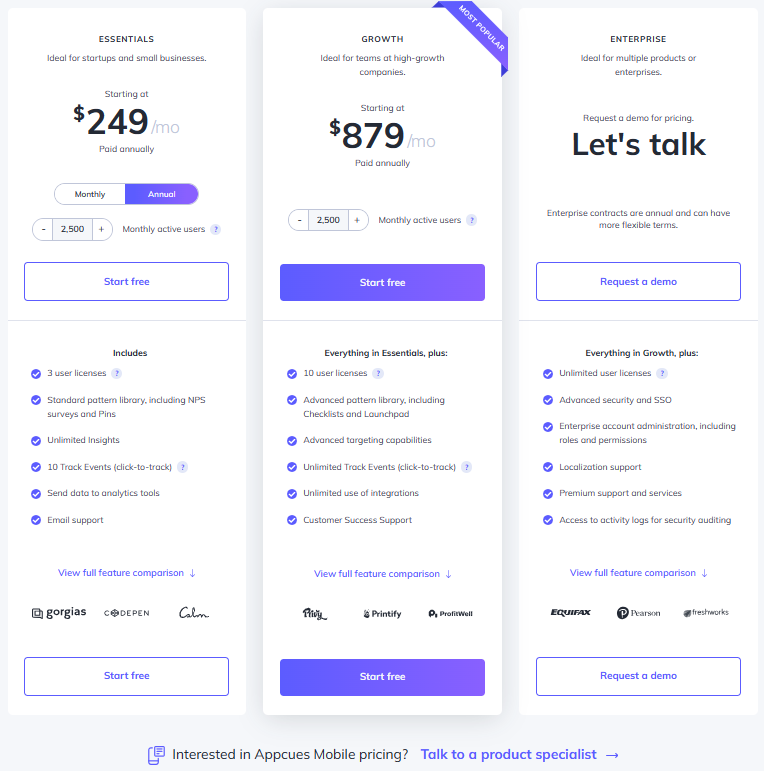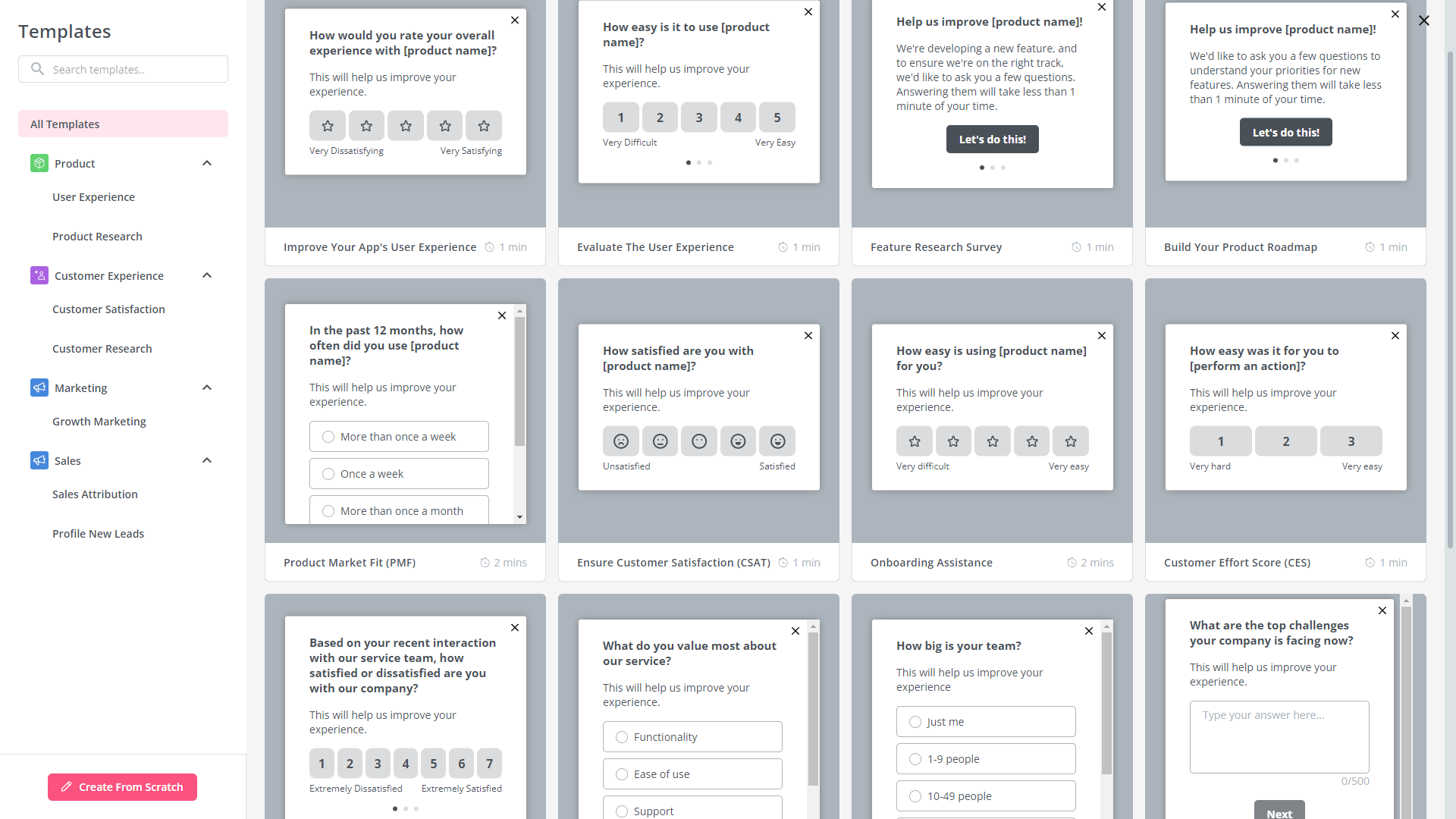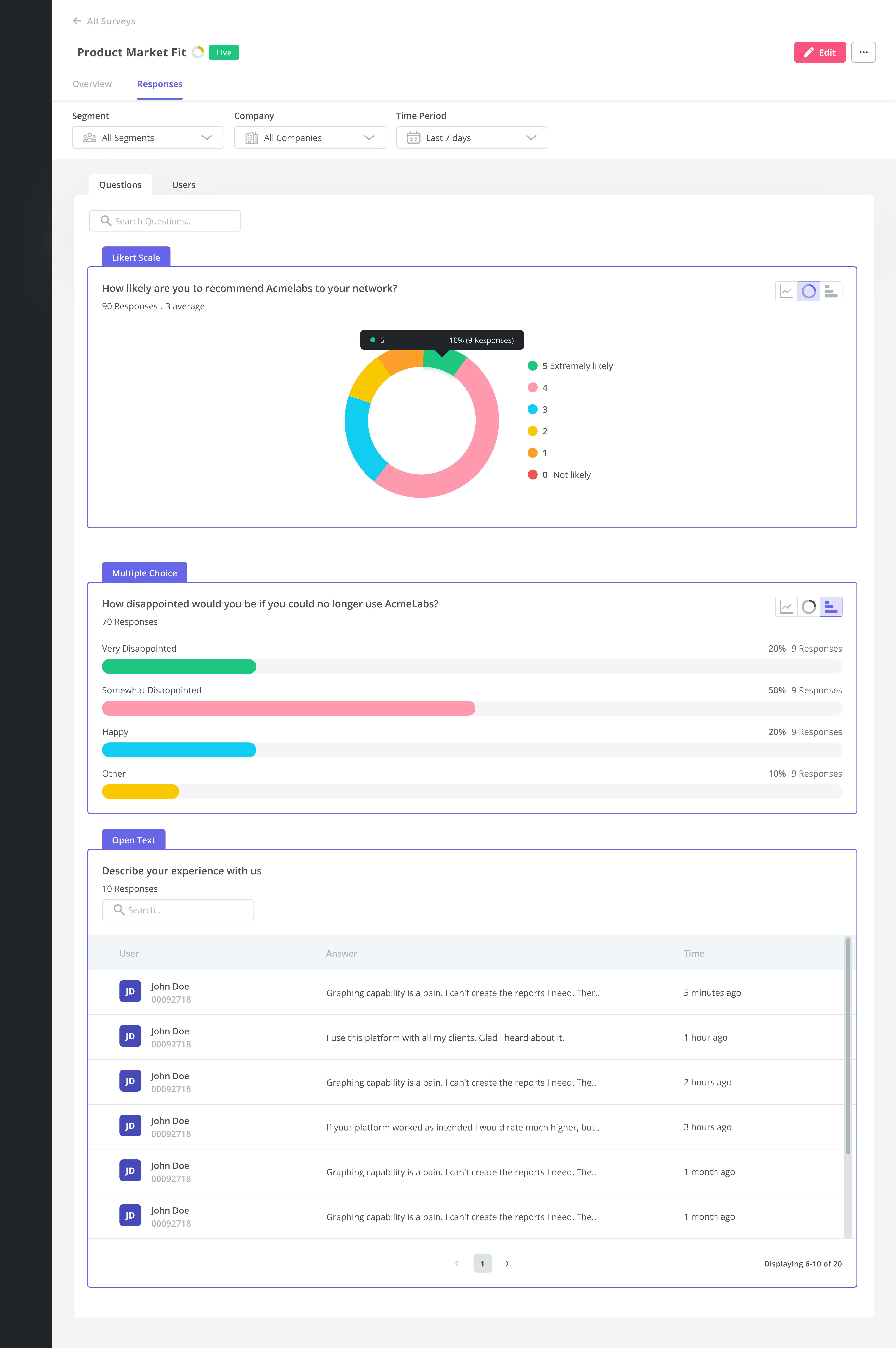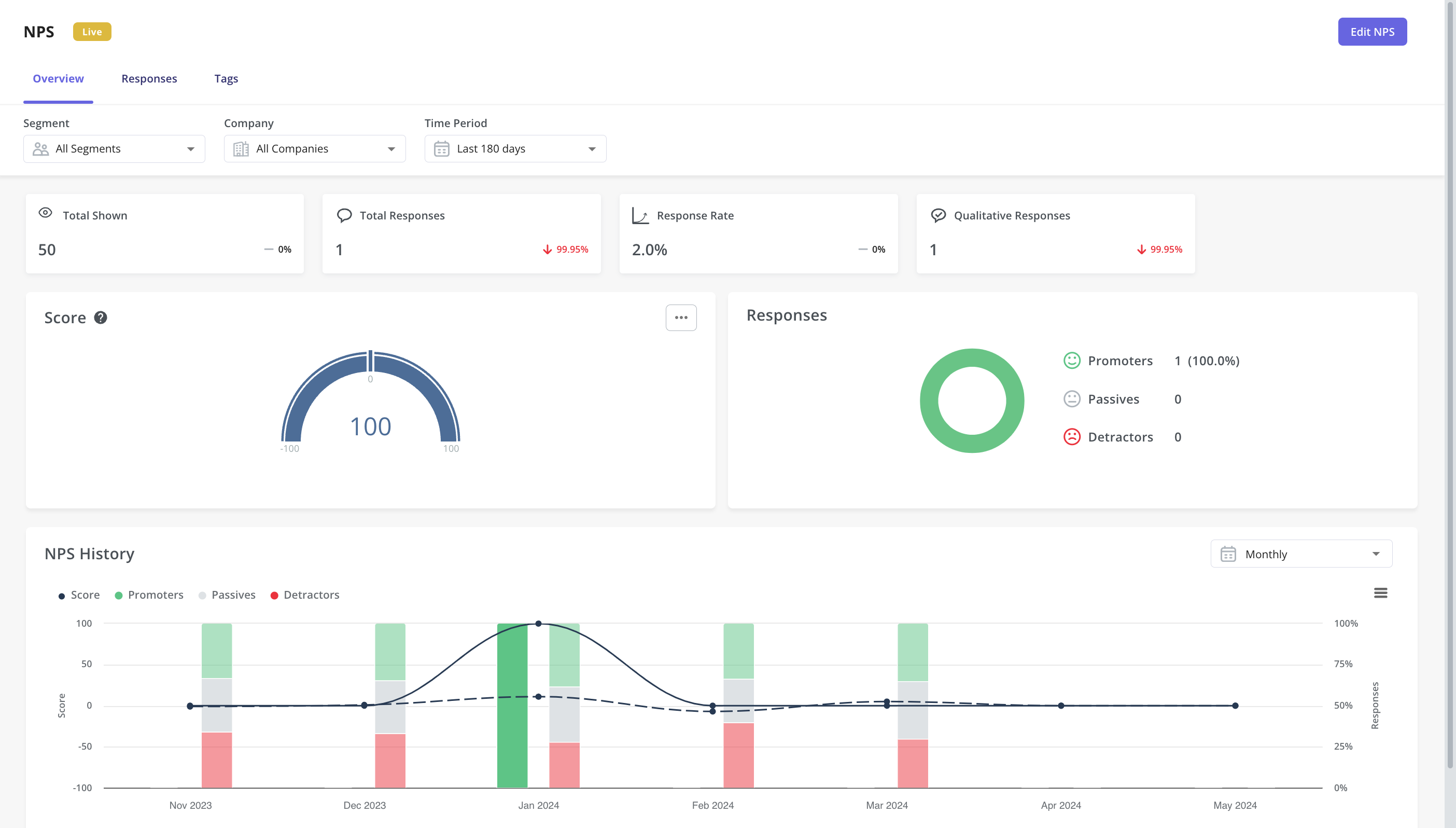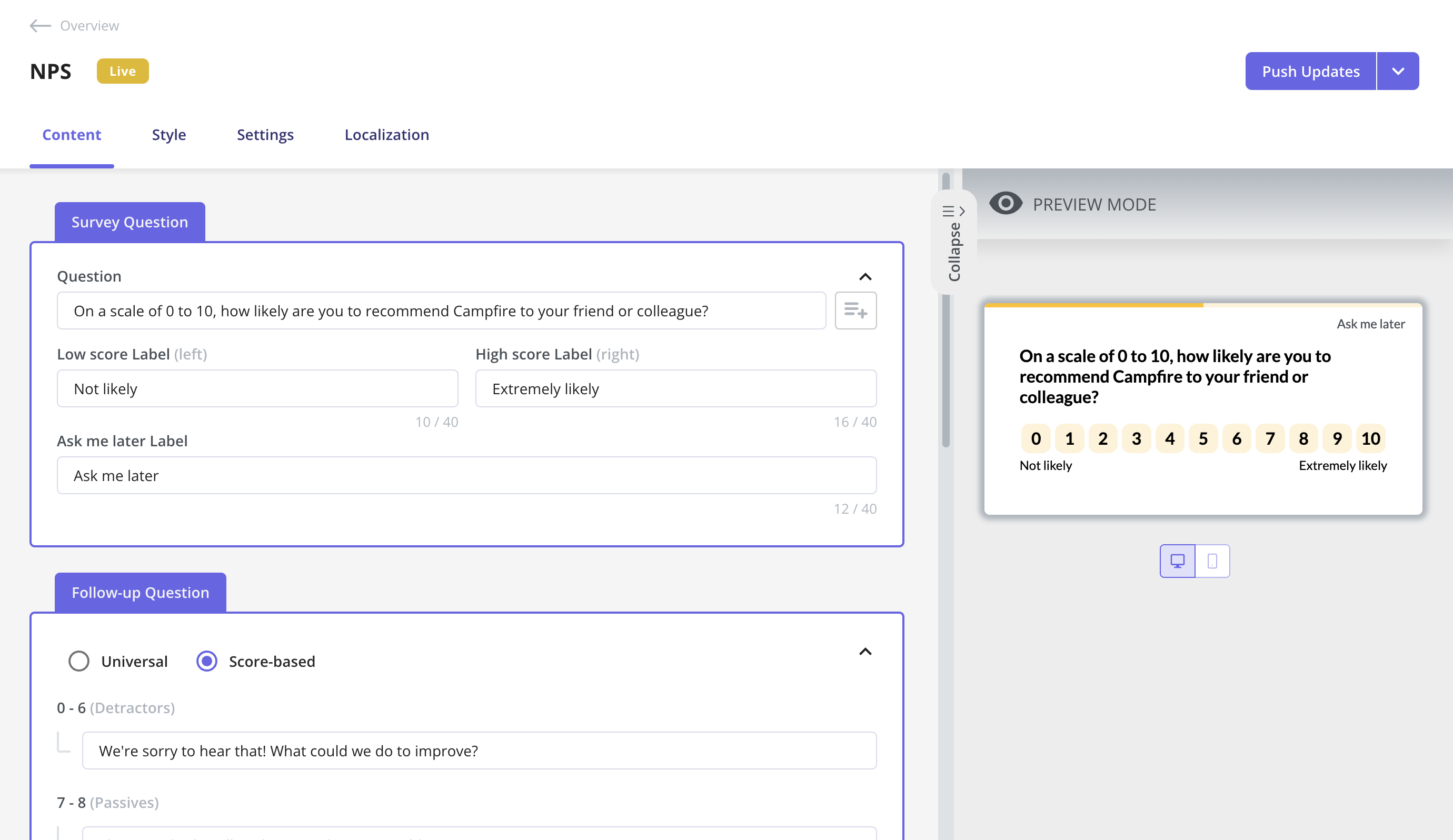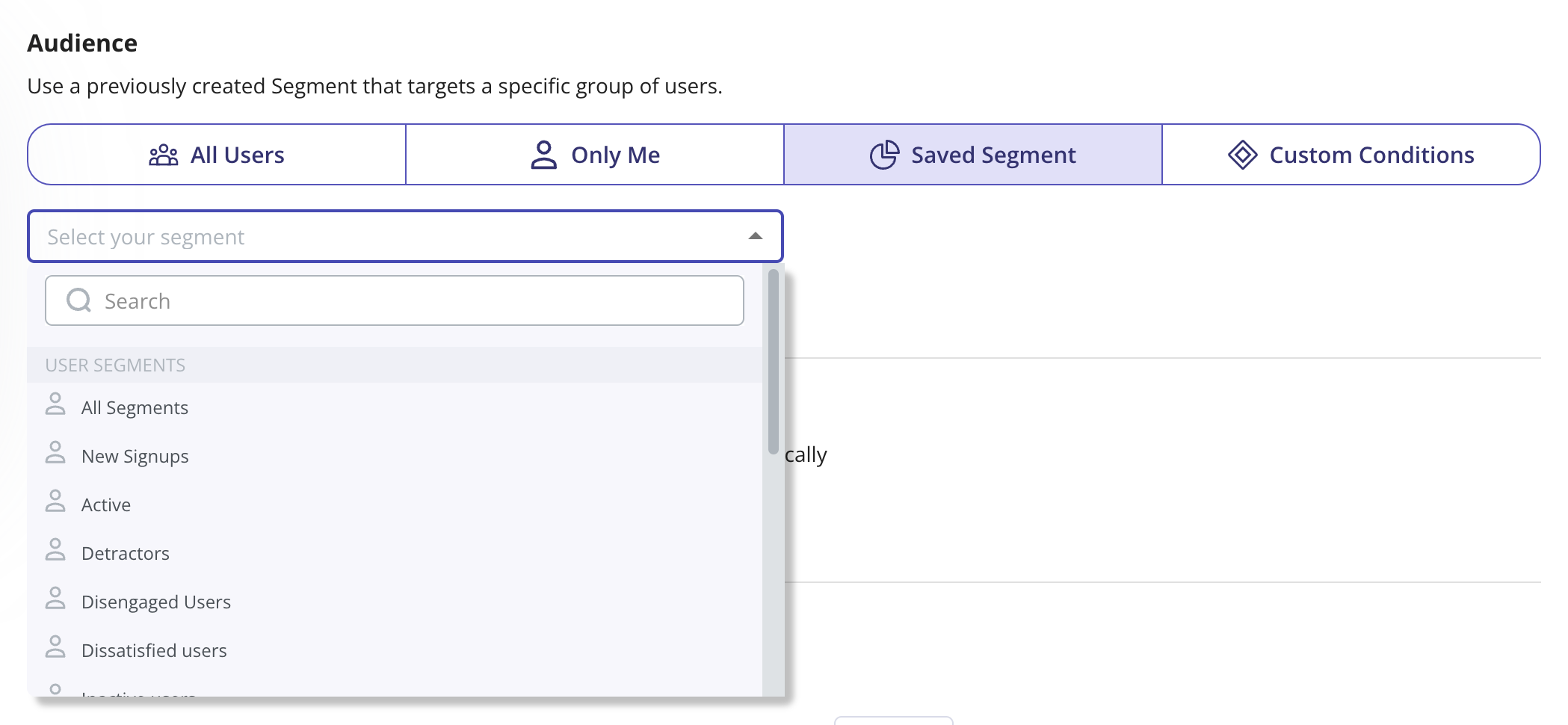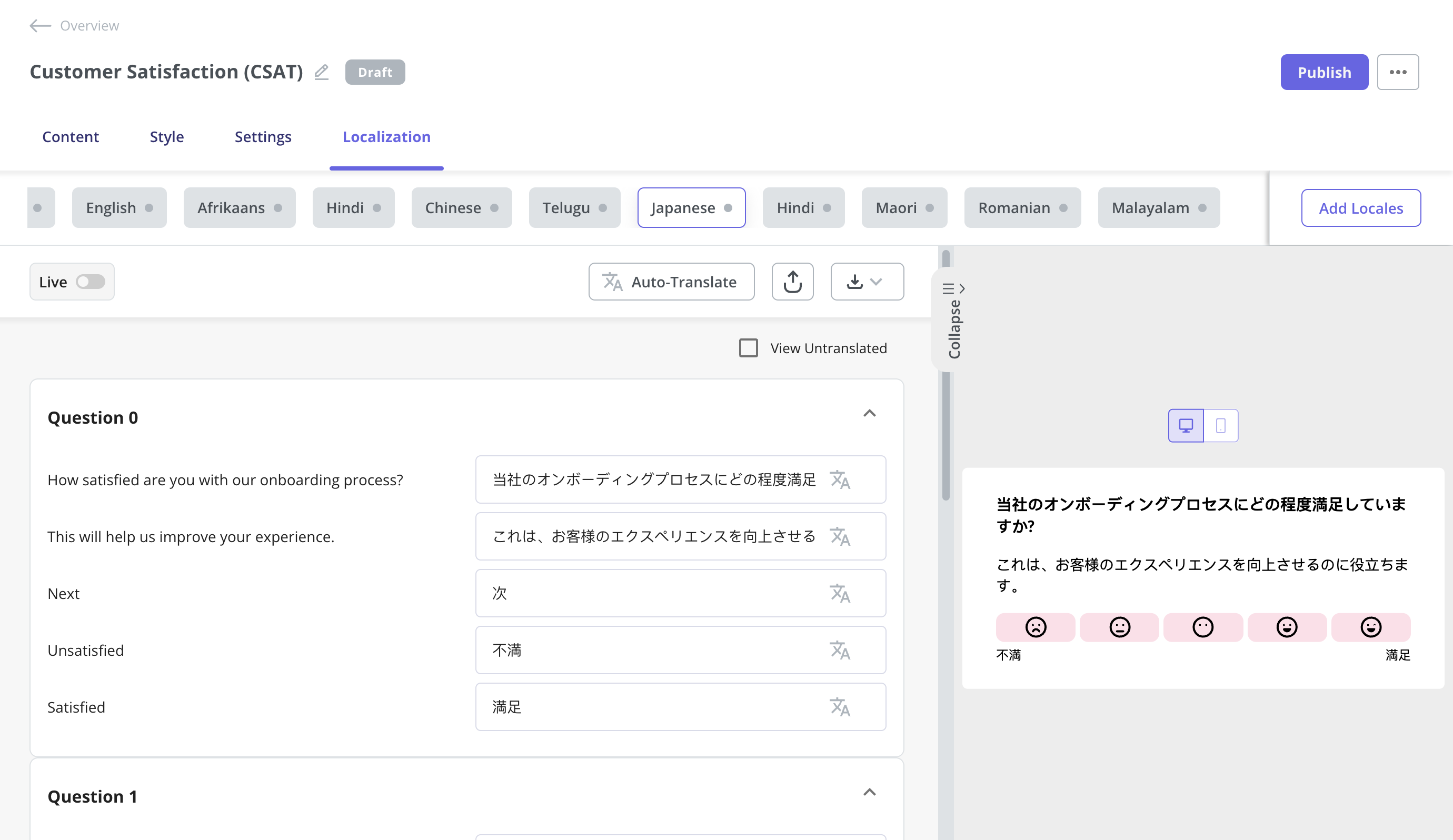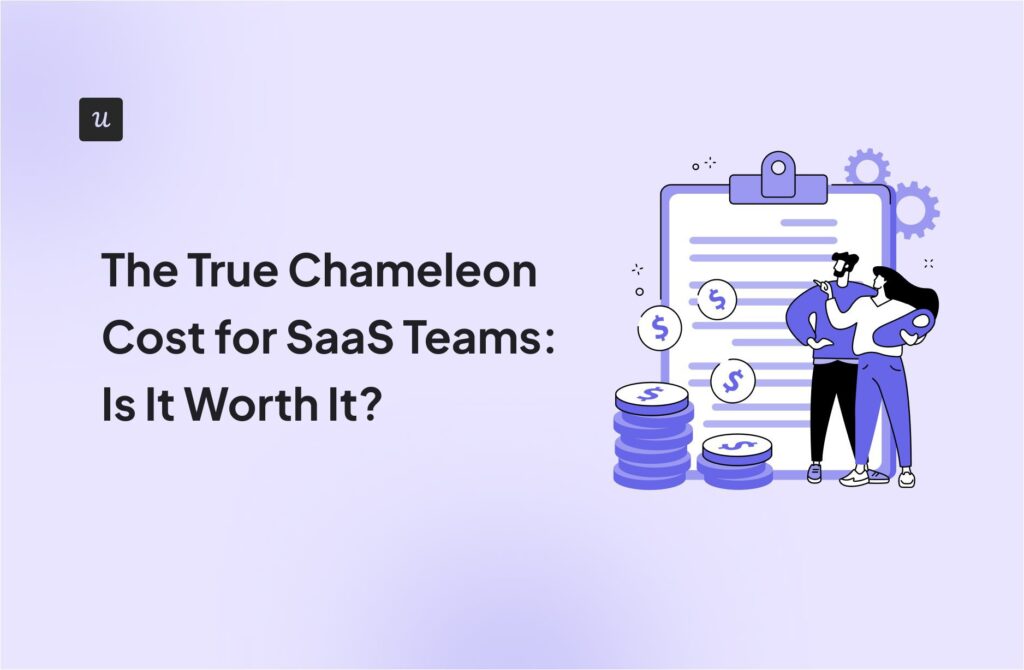
Try Userpilot Now
See Why 1,000+ Teams Choose Userpilot

Appcues vs Whatfix: Which one is a good choice for customer feedback?
- Let’s explore how Appcues and Whatfix compare when it comes to collecting customer feedback.
- Appcues is a robust product adoption and user onboarding platform for web and mobile apps. It enables product teams to create, implement, and test personalized in-app onboarding experiences. The platform also helps you announce new product features and collect customer feedback.
- Whatfix lets you run NPS surveys, survey mobile users, and gather feedback from the self-help widgets.
- Considering functionalities and value for money, Userpilot is a better choice when it comes to collecting customer feedback. With features such as NPS surveys, in-app surveys, and survey analytics, it can help you with collecting and analyzing customer insights without coding.
- Get a Userpilot demo and drive your product growth code-free.
Must have features for customer feedback tools
On the lookout to find the best customer feedback tools? We’ve curated a list of the best tools that are trustworthy:
- Userpilot: best customer feedback tool for creating NPS surveys without Userpilot branding and with NPS tagging capability.
- Appcues: best customer feedback tool for creating mobile surveys.
- UserGuiding: best customer feedback tool for creating different types of microsurveys.
- Pendo: best customer feedback tool for feedback analytics.
- Chameleon: best customer feedback tool for contextual in-product feedback.
Let’s dive deeper into how each stacks up for different company sizes, budgets, and jobs to be done!
Appcues for customer feedback
As a product adoption platform, Appcues offers limited features that enable you to collect customer feedback. There is only one type of survey available (Net Promoter Score), and it comes with templates and analytics.
- NPS templates: You can customize pre-built NPS templates using the drag-and-drop builder.
- NPS targeting: Use NPS results to encourage promoters to review your product on app stores or ask detractors for more feedback.
- You could add a survey lookalike on top of a modal, but that means you won’t be collecting and analyzing results easily, defeating the purpose of using a survey for user feedback.
NPS surveys in Appcues
Appcues simplifies the process of creating and implementing in-app NPS surveys. You can set up the survey from Appcues Studio and customize it to match your brand image.
Besides no-code survey design, Appcues also lets you:
- Preview the survey before publishing it in real-time.
- Access, analyze, and import in-depth survey results.
- Segment users based on survey results and target them with personalized messaging.
However, it’s worth noting that when it comes to breaking down NPS survey results, Appcues has a few limitations as it only gives you the score and answers. You can’t tag responses or do more in-depth analysis unless you download a CSV file with all answers and do a manual analysis.
Other platforms like Userpilot do a better job of breaking down responses by score, behavior patterns, and other parameters.
In-app surveys in Appcues
Appcues only lets you create NPS surveys to collect feedback from customers. You can use a workaround and add a microsurvey to a modal, but this won’t be collecting any analytics, and analysis responses will be difficult.
If NPS surveys are enough for you, here’s what Appcues offers:
- NPS: The most commonly used survey option is NPS, which lets you identify loyal users and detractors.
- Survey analytics: You can track, analyze, and visualize NPS survey results. It’s also possible to export the results into a PDF file.
- Target and trigger your NPS survey to specific audiences.
Whatfix for customer feedback
User feedback is essential to gather data on how customers or employees interact with a particular tool and which challenges they might face while doing so. Whatfix has surveys, NPS surveys, and feedback forms that give your users a voice.
Here’s how you can use Whatfix to collect customer feedback:
- Whatfix’s feedback forms give your employees and customers a chance to share their experience while using a particular product or feature. These input fields could be used to collect broad qualitative feedback or ask users about a specific feature.
- You can also build NPS surveys with open-ended and multiple-choice questions in addition to the standard 1-10 scalar ratings. Unfortunately, you’ll only be able to edit, delete, or reorder these questions if you upgrade to the Premium plan.
- If you’re developing a mobile app for customers or require that employees use a mobile-based application, Whatfix can help you build app-specific surveys. These surveys can take up the entire screen of a mobile device, pop up in the middle, or come from the bottom.
NPS surveys in Whatfix
NPS surveys are a tried-and-tested way of measuring customer loyalty and advocacy. Whatfix lets you gather NPS data through no-code surveys, automatically calculates scores, and lets you pull data into third-party integrations like Power BI.
Here’s an overview of how Whatfix helps you track your Net Promoter Score:
- No-Code Surveys: Whatfix’s gallery of no-code widgets includes NPS surveys as an option. This means that all users can create an in-app NPS survey without writing any code. However, only Premium users will be able to edit, reorder, and delete questions within NPS surveys.
- Survey Analytics: If you include an NPS question in your survey, then the AI-generated summary will automatically calculate the score based on the responses you received. These automatic survey analytics can save you some number-crunching time.
- Power BI: Whatfix has a direct integration with Power BI — a data visualization tool from Microsoft. This lets you sort data by users with a Net Promoter Score below six so you can map their usage patterns and identify the product problems that create detractors.
In-app surveys in Whatfix
In-app surveys are the most efficient way to collect customer feedback because they let you capture user feedback at the exact moment that people are using your product. Whatfix lets you run NPS surveys, survey mobile users, and gather feedback from the self-help widgets.
- NPS Surveys: Whatfix’s NPS surveys can include multiple choice and open-ended questions alongside the usual 1-10 rating scale. Sadly, you’ll need to upgrade to a Premium subscription if you want to edit, reorder, or delete any of these questions.
- Mobile Surveys: Whatfix Mobile lets you gather feedback from users on mobile devices so you can acquire insights into the mobile experience. Whatfix’s mobile surveys could appear as full-screen popups, show up in the middle of the screen, or slide out from the bottom.
- Self-Help Widget: The self-help widget (which is always visible on the right side of a user’s screen) is primarily used to access documentation or resources from within a product. However, it also has feedback collection forms so you can ask users how helpful your content is.
Pros and cons of Appcues
Are you wondering if Appcues is the right fit for your user onboarding needs or if you should check out other options?
Here are a few reasons why using an Appcues alternative makes sense:
- You want more customizability. Customization options on Appcues are limited to color, size, and style. Advanced customization will require you to work with CSS code. It can be a roadblock when your team members lack technical expertise, leaving you dependent on developers.
- You’re on a budget. With Appcues, you’ll have to pay more to access advanced features like custom CSS, localization or even simple checklists. If you’re a startup or small business with a limited budget, you might benefit from using a tool like Userpilot that offers more value for money.
- You want to collect detailed customer feedback. Appcues offers limited functionality in terms of surveys. If you want to explore other survey and feedback collection formats apart from NPS, Appcues may not be an ideal choice.
Pros of Appcues
As a first-comer in the no-code product adoption landscape, Appcues offers several valuable features. It’s suitable for mid-market SaaS businesses looking for a simple, easy-to-use tool that enhances user onboarding, retention, and the overall customer experience.
Let’s take a closer look at the benefits of Appcues:
- Intuitive UI and UX: Appcues offers a straightforward interface that’s easy to navigate and use. Users with non-technical backgrounds can design captivating in-app flows and onboarding journeys with its simple drag-and-drop builder. You can tailor user journeys with various UI patterns, from modals and hotspots to tooltips, slideouts, and banners.
- Simple setup: You can get started with Appcues in minutes by adding the SDK to your app’s source code or integrating Appcues with Segment or Google Tag Manager. Then, add a Chrome extension to launch the Appcues Builder in a few quick clicks and start creating in-app flows.
- Feedback options: Create Net Promoter Score (NPS) surveys to collect actionable user feedback. You can even check and analyze NPS analytics on your Appcues dashboard.
- Mobile onboarding: Besides web apps, you can use Appcues to create end-to-end experiences for mobile apps. It supports various mobile environments, including Native Android, Native iOS, React Native, Flutter, and Iconic.
- Extensive integrations: Appcues integrates with 20+ email automation, CRM, and analytics tools, including Heap, Zapier, HubSpot, Google Analytics, and Google Tag Manager. Many of these include two-way integrations.
Cons of Appcues
Appcues comes with a ton of useful features you’d expect from a leading product adoption platform, but it does have a few shortcomings.
Let’s look at a few drawbacks of Appcues:
- Poor element detection: The Appcues algorithm occasionally struggles to detect in-app elements, unlike some of its competitors like Userpilot. It’s particularly limiting when you want to add tooltips to individual options in a dropdown menu.
- Limited customization capabilities: While Appcues lets you customize pre-designed templates, you’re limited to basic options like font style, size, color, and padding. Advanced customization requires working with CSS code, which can be challenging for non-technical teams.
- Basic analytics: Appcues provides insights into product usage and customer behavior. However, you can’t access in-depth analytics without connecting to a third-party tool like Amplitude or Google Analytics.
- Limited survey options: Appcues lacks variety in feedback collection and survey options and doesn’t offer integrations with other platforms like Google Forms and Typeform. You can only build NPS surveys. This is in contrast to some of its competitors, like Userpilot, which offers an extensive library of customizable survey templates.
- Higher pricing: Starting at $249 per month, the Appcues Essential tier has several constraints, such as limited UI patterns and no custom CSS support. Moreover, localization support is only available in the Enterprise tier. If your app is multilingual, you’ll have to shell out a ton of money to make the most of Appcues.
- No live chat: While Appcues offers educational resources and a help center (Help Docs), customer support is limited to email and phone.
Pros and cons of Whatfix
Whatfix is priced lower than its closest competitor (WalkMe) while letting you onboard both customers and employees to software applications. That said, there are a few clear scenarios where you might want to look for alternative solutions:
- If you’re the type of customer who wants to “try before they buy”, then Whatfix isn’t going to be the right fit. The trial request form on their website is buggy, you’ll need to wait a month to hear back on your request, and you might end up with a demo instead of a trial.
- Many customers have complained about the subpar support that Whatfix offers. There are multiple reviews on websites like G2 citing slow resolution times, high success manager turnover, and an overall lack of technical assistance from the Whatfix team.
- Despite claiming to be built for enterprise organizations, Whatfix’s analytics capabilities leave much to be desired. If you’re looking for advanced analytics capabilities, then find alternatives like WalkMe, Userpilot, or Appcues.
Pros of Whatfix
Whatfix may not be as popular or widely adopted as competitors like WalkMe, but it does have its fair share of benefits:
- Pricing: While Whatfix does not publish the exact cost of its plans publicly, numerous reports from customers suggest an average entry point of $1,000/month. This is significantly cheaper than its closest competitor, WalkMe, which reportedly starts at closer to $10,000/month.
- Automation: Whatfix Flows helps you automate repetitive tasks to save time. The Whatfix Flows dashboard also lets you analyze your existing flows and then use them to create entirely new automation in a single click.
- Integrations: Whatfix’s third-party integration options make it easy to incorporate the solution into the rest of your tech stack. It integrates with Salesforce, Amplitude, Google Analytics, Slack, and more — providing a good selection of the top CRM, analytics, and communication tools.
Cons of Whatfix
Whatfix offers a more affordable employee onboarding solution than its closest competitors but is limited by its lackluster analytics and support — along with its high-friction trial signup process for prospective customers.
Here are the key drawbacks of using Whatfix:
- Whatfix is quite lacking in the analytics department — both in comparison to direct competitors like WalkMe as well as other onboarding solutions like Userpilot, Appcues, or Pendo. If detailed user data matters to you, you’ll want to consider alternatives.
- Technical assistance (or the lack thereof) is arguably one of Whatfix’s largest weaknesses. While all plans promise to give you a customer success manager, most Whatfix users complain about the subpar support they provide.
- While Whatfix has a trial request page on its website, this form is buggy and inconsistent. You can reach out to support to request a trial directly but resolution times can be upwards of a month — and, in the end, you may even be redirected to a demo call instead of a trial account.
Appcues vs Whatfix: Which one fits your budget?
Understanding the cost implications is paramount when selecting the right solution for customer feedback, so here’s a detailed pricing comparison of Appcues and Whatfix.
Pricing of Appcues
Pricing for Appcues starts at $249 per month, with the platform offering three distinct tiers – Essentials, Growth, and Enterprise.
The total cost can vary depending on the number of monthly active users (MAU). For instance, the Essential plan starts at $249 per month for 2500 MAU but jumps to $299 for 5000 MAU.
Here’s a detailed glimpse of the different pricing tiers:
- Essentials: It’s the basic tier that starts at $249 per month. It includes 3 user licenses and lets you add up to 5 audience segments. Some UI patterns, such as checklists, launchpads, and custom CSS support, aren’t available. Customer support is only available through email.
- Growth: This tier starts at $879 per month (for 2500 monthly active users) and includes 10 user licenses. You can target unlimited audience segments and use the full spectrum of UI patterns. Additionally, you can access the Premium Integrations package, which includes integrations with Slack, Salesforce, Marketo, and Zendesk.
- Enterprise: This is the most feature-packed tier and includes robust security controls like role-based access and activity logs. It’s also the only tier that comes with multi-account and localization support. Besides email and phone support, you also get a dedicated Customer Success Manager and Technical Implementation Manager. Pricing is available on request.
All three plans come with a 14-day free trial, where you can test unlimited flows and track up to 5 events. You can extend the trial by another 14 days by installing the Appcues SDK in your app. Additionally, you don’t need a credit card to sign up for the free trial.
Keep in mind that the above pricing plans are applicable to web apps. Pricing for Appcues Mobile is available on request.
It’s also worth noting that Appcues is pricier than some of the other product adoption tools available in the market, including Userpilot. For instance, Userpilot’s basic tier (Starter) lets you add up to 10 audience segments and includes the complete set of UI patterns.
Pricing of Whatfix
Whatfix doesn’t have public pricing listed on its website. It also charges separately for its product analytics solution but we won’t be going over those plans since we’re focusing on the digital adoption platform.
Here’s an overview of the three plans available for Whatfix web:
- Standard: This includes core features like in-app guidance, contextual guidance, a multi-media knowledge base, and content aggregation capabilities. It also includes access to pre-built surveys and up to two integrations.
- Premium: This includes additional features such as automatic content localization, automated flow testing, unlimited integrations, and single sign-on (SSO). You’ll also be able to build custom surveys while on the Premium plan.
- Pro: This includes the features from previous plans as well as enterprise-exclusive options such as self-hosting. This plan is targeted towards customer-facing applications with a million or more users.
Userpilot – A better alternative for customer feedback
User feedback is an essential part of listening to the Voice of the Customer (VoC) and making product development or marketing decisions that best suit your customer base. Userpilot has a no-code survey builder, 14 templates to choose from, and advanced analytics for extracting insights.
Here are the Userpilot features you can use to collect customer feedback and analyze it:
- Survey builder: Userpilot’s survey builder lets you edit the content, update the widget’s style/placement, and set page-specific or event-specific triggers to ensure that users see the survey at the most contextual moment — all without writing a single line of code. You can also translate surveys into your audience’s native language.
- Survey templates: There are 14 survey templates to choose from with a wide array of different use cases. You can collect qualitative responses on how to improve the user/product experience or quantitative data for customer satisfaction benchmarking, such as CSAT and CES scores.
- Advanced analytics: Userpilot’s advanced survey analytics will show you what the most common responses were, what percentage of users selected a specific option, and display open-ended feedback about your product or specific features.
Survey analysis in Userpilot. - NPS dashboard: Userpilot’s NPS dashboard compiles response data from all NPS surveys, so you don’t have to manually go into each survey and check its analytics. You’ll be able to view key metrics like response rates, total views, and NPS history and sort all the data by different segments.
NPS dashboard in Userpilot. - NPS response tags: Userpilot comes with NPS response tags that you can use to categorize qualitative NPS answers for analyzing purposes. You can use these tags to identify common issues among passives and detractors or find satisfaction drivers among promoters.
NPS response tags.
NPS surveys in Userpilot
The Net Promoter Score (NPS) is a reliable measure of how satisfied customers are and how likely they are to recommend your product to others. Userpilot lets you build NPS surveys, analyze response data, and target specific user groups to gather actionable insights.
Here are the Userpilot features you can use when sending NPS surveys:
- No-code builder: The survey builder lets you edit the content of your NPS surveys, style the widget to your liking, restrict surveys to specific pages/paths, and use AI-powered localization to change the language of your survey.
- Audience targeting: Userpilot’s audience targeting features let you choose which users to include in NPS surveys. You could set this to all users, select only me if you’re still in the testing stage, target a particular segment, or set conditions that must be met for a survey to appear.
Userpilot offers multiple options for delivering your NPS surveys to users. - Analytics dashboard: Userpilot’s dedicated NPS dashboard shows you all the key data gathered from your surveys. These include how many views your NPS surveys have gotten, the number of responses, the overall response rate, and how the score has been trending over time.
NPS dashboard in Userpilot. - NPS response tags: Userpilot comes with NPS response tags that you can use to categorize qualitative NPS answers for analyzing purposes. You can use these tags to identify common issues among passives and detractors or find satisfaction drivers among promoters.
In-app surveys in Userpilot
In-app surveys are an effective way to collect direct feedback from users without being at the whim of their email inboxes. Userpilot’s built-in functionality lets you create surveys, translate them, and track granular survey analytics that offer additional user insights.
Here are the Userpilot features you can use when building in-app surveys:
- Survey templates: Userpilot’s no-code survey builder has 14 templates to choose from. These include NPS, CSAT, and CES surveys among others for collecting quantitative and qualitative feedback from users. You can add a series of questions to gather valuable insights.
- Survey translation: Userpilot’s AI localization feature lets you translate surveys in a matter of minutes. All you need to do is add the desired locale and leave the rest to Userpilot. You can also make manual tweaks to translations if needed.
- Advanced analytics: Userpilot has detailed analytics that show what percentage of users chose a specific option, summarizes the most popular choices, and lets you browse through open-ended responses to extract insights from qualitative feedback.
Survey analysis in Userpilot.
Pricing of Userpilot
Userpilot offers flexible pricing built around access to product analytics, in-app experiences, and user engagement tools without locking key features behind higher tiers.
Here is a quick breakdown of its pricing plans:
- Starter: $299/month, billed annually
Designed for early-stage teams. You get product analytics, NPS surveys, basic segmentation, and in-app flows. Monthly billing isn’t available. - Growth: custom pricing
Includes everything in Starter, plus resource center analytics, advanced targeting, and a dedicated Customer Success Manager. - Enterprise: custom pricing
Built for larger teams that need SAML SSO, premium integrations, audit logs, and security controls.
Advanced features like funnels, cohorts, and trend reports start on the Growth plan. You don’t pay extra for feature usage or UI patterns.
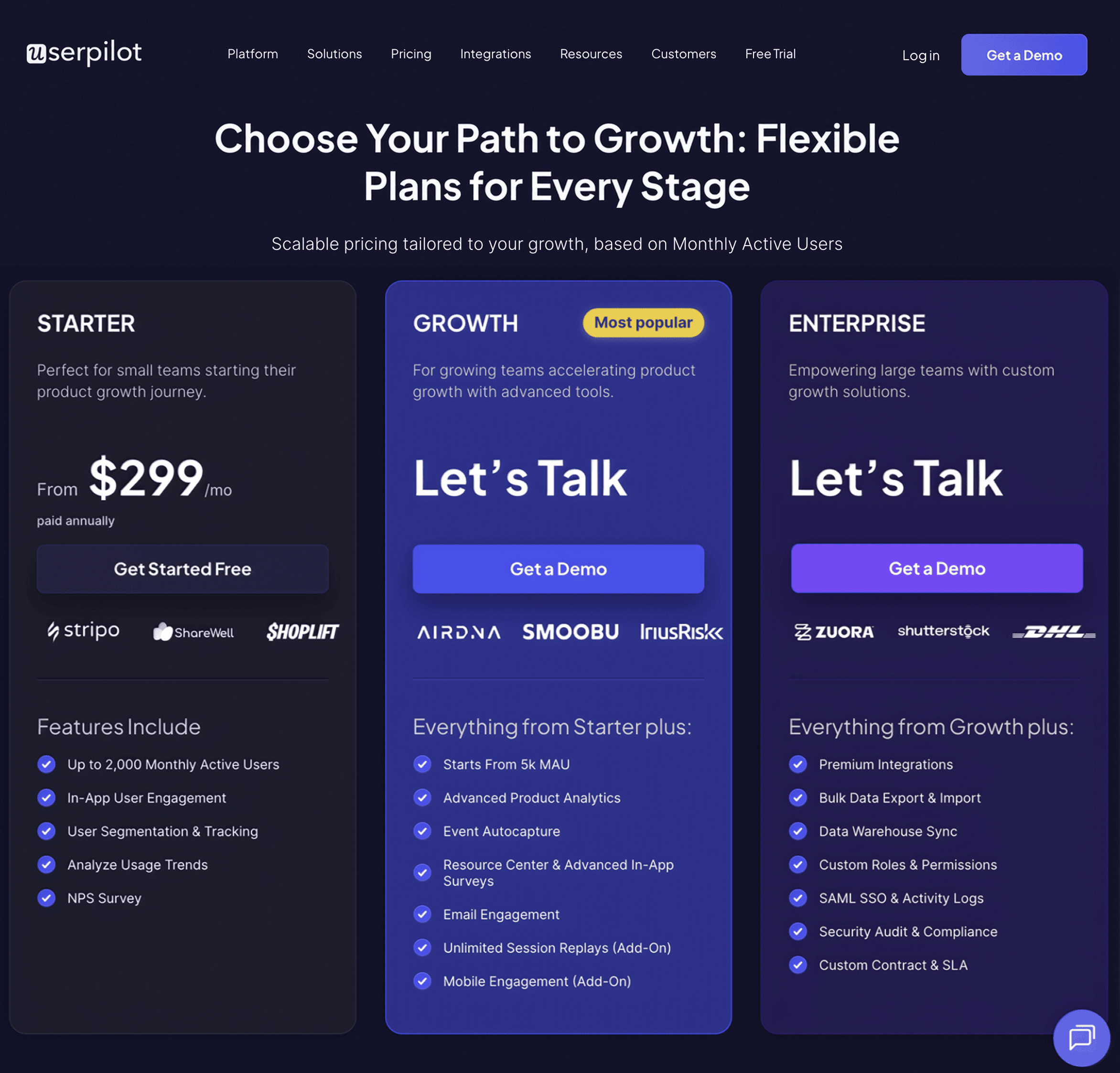
What do users say about Userpilot?
Most users laud Userpilot for its versatile feature set, ease of use, and responsive support team:
I recently had the pleasure of using Userpilot, and I must say it exceeded all my expectations. As a product manager, I’m always on the lookout for tools that can enhance user onboarding and improve overall user experience. Userpilot not only delivered on these fronts but also went above and beyond with its impressive new features, unparalleled ease of use, and truly exceptional customer support.
What truly sets Userpilot apart is its outstanding customer support. Throughout my journey with Userpilot, the support team has been responsive, knowledgeable, and genuinely dedicated to helping me succeed. Whenever I had a question or encountered an issue, their support team was always there to assist promptly, going above and beyond to ensure my concerns were addressed effectively.
Source: G2.
Of course, other users are also kind enough to share constructive criticism regarding specific features like event tracking filters:
“The filtration while analyzing specific events is a little confusing. Understanding of custom properties and data management configuration could have been more organised.”
Source: G2.
Conclusion
This is the end of our thorough comparison between Appcues and Whatfix. You should be able to make a confident decision by now. If you’re looking for a solid tool for customer feedback that promises great value for money, give Userpilot a go. Book a demo today!


